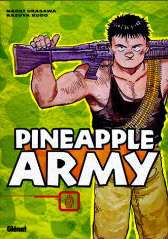Pineapple Army
Pineapple Army (Japanese: パイナップルARMY, Hepburn: Painappuru Āmī) is a Japanese manga series written by Kazuya Kudo and illustrated by Naoki Urasawa. It was serialized in the magazine Big Comic Original from 1985 to 1988, with the individual chapters collected into eight tankōbon by Shogakukan. The series initially takes place in New York, but because its editor believed the magazine's demographic was men in their 40s, the setting changes to Europe at a certain point.[2]
| Pineapple Army | |
 Cover of Pineapple Army, published by Glénat on August 1, 1998 | |
| パイナップルARMY (Painappuru Āmī) | |
|---|---|
| Genre | Action, military fiction[1] |
| Manga | |
| Written by | Kazuya Kudo |
| Illustrated by | Naoki Urasawa |
| Published by | Shogakukan |
| English publisher | Viz Media |
| Magazine | Big Comic Original |
| Demographic | Seinen |
| Original run | 1985 – 1988 |
| Volumes | 8 |
Viz Media licensed Pineapple Army for English release in North America, but it was canceled after only ten issues. The manga is also licensed in France by Glénat,[3] in Spain by Planeta DeAgostini Comics, and in Sweden by Epix Förlag.[4]
Plot summary
The series stars Japanese-American Jed Goshi (ジェド・豪士), a former United States Marine who served in the Vietnam War. After leaving the marines he fought all over the world as a mercenary, before retiring in 1979. Now living in New York, he makes a living training others in combat. Goshi does not discriminate against those he trains, whether its Bengali militiamen, salarymen, or four little girls.
Publication
Written by Kazuya Kudo and illustrated by Naoki Urasawa, Pineapple Army was serialized in the magazine Big Comic Original from 1985 to 1988. It is Urasawa's first major work and he would go on to draw Yawara! simultaneous with it. The individual chapters were collected into eight tankōbon by Shogakukan between March 29, 1986 and July 30, 1988. A six-volume bunkoban edition was published between November 17, 1995 and March 16, 1996.[5][6]
In 1988, Viz Media began publishing Pineapple Army in English in a chapterly comic book format. These had new cover art drawn in a drastically different art style by an unknown artist.[1] But the run was unsuccessful and cancelled after ten issues were released. Although, one graphic novel collecting them was also published with an afterword by James D. Hudnall.[1]
Reception
Manga critic Jason Thompson stated that Pineapple Army was a modest success in Japan, but failed in America. He speculated that Viz's decision to commission new covers by an unknown artist drawn in a "Dave McKean-style" might have been misleading when the reader opened them and saw little girls throwing hand grenades.[1]
In 2012, Thompson said that Pineapple Army was his least favorite Urasawa work available in English. While the art is good, he felt the artist had not developed his own style yet and showed too much of his Katsuhiro Otomo influence. Thompson largely compared it to Golgo 13 (which Kudo previously wrote for) with its self-contained mercenary stories, but stated that the chapters are much shorter and thus feel rushed.[1]
References
- "Jason Thompson's House of 1000 Manga - Pineapple Army". Anime News Network. March 29, 2012. Retrieved February 16, 2020.
[...]Pineapple Army, which was self-contained and had a military-action theme[...]
- "INTERVIEW: All You Need is a White Piece of Paper and Pen: A Conversation with Monster and 20th Century Boys Creator Naoki Urasawa". Crunchyroll. February 6, 2019. Retrieved February 14, 2020.
- "Pineapple Army" (in French). Animint. Retrieved June 25, 2009.
- "Pineapple Army" (in Swedish). daisuki.se. Archived from the original on August 14, 2010. Retrieved June 25, 2009.
- "パイナップルARMY〔小学館文庫〕 1" (in Japanese). Shogakukan. Retrieved February 17, 2020.
- "パイナップルARMY〔小学館文庫〕 6" (in Japanese). Shogakukan. Retrieved February 17, 2020.